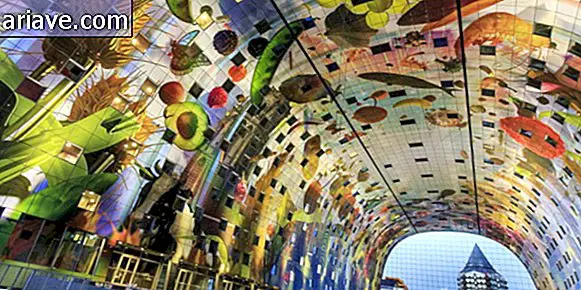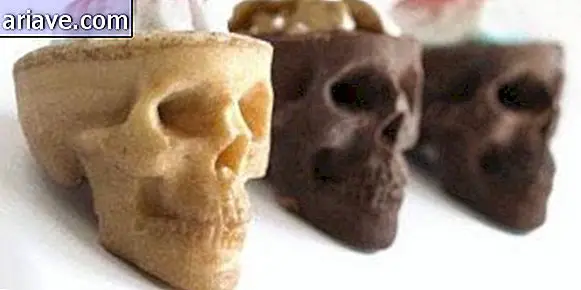Marvel at the exotic beauty of 14 transparent animals
We have already gathered here at Mega Curioso some of the most colorful species in nature. Now is the time to see a selection of transparent animals. But don't be fooled! It is not only because some exotic species are devoid of color that they are no longer interesting.
When the colors leave the scene, we can appreciate these animals in a new way and their unusual forms become even more prominent. You will find that transparency also varies by species - some animals look like glass, while others still have colored body parts or have this curious feature only during one phase of life.
Then learn more about these fascinating, almost invisible creatures that inhabit different parts of the planet.
1) Phantom Shrimp ( Macrobrachium jelskii )

These tiny crustaceans have semi-translucent shells that make them practically disappear in aquariums where they are often kept. In nature, different species can be found in rivers and lakes around the world. Its appearance so easily misleads the eyes that it is more likely to identify it after it feeds on something colorful. A good example of this is when the shrimp eats plants and turns greenish.
2) Macropinna microstoma
This fish is considered by many to be one of the weirdest creatures on the ocean floor. Probably this fame comes from its different look, which includes a transparent head and eyes (which are these greenish tubular structures) that stay inside your body. The explanation is that if the animal's head were colored, it would not be able to see just as clearly. The animal is able to rotate its eyes in different directions to search for its prey. When they are pointed upwards, as in the picture, it is because the fish is looking for food. And don't be confused: those two holes in the front of the animal work just like nostrils.
3) Vitreledonella richardi

This octopus, which seems to have been made of glass, looks so unusual that it has earned its own classification: the family Vitreledonellidae . Little is known about this marine animal that has been found in tropical and subtropical waters in different parts of the world. Thanks to its transparent skin, researchers know that its eyes have rare elongated optic nerves, indicating that this animal has sharp eyesight. It would be nice if we had as sharp a view as this octopus to admire its exotic beauty.
4) Glass toad ( Centrolenidae)

Even with some coloring, these amphibians could not be part of this list. This is because the Centrolenidae family frogs have an extremely transparent abdomen. In this way, some internal organs - such as the heart, liver, and digestive system - can be easily seen through translucent skin. These frogs can be found in forests of Central and South America, where they usually live high in the trees.
5) Glass-winged Butterfly ( Greta oto )

As its name implies, the great differential of this species of butterflies is that their wings are transparent as if they were made of glass. After all, if it weren't for the traditionally dark outlines, we would hardly see this insect resting on a leaf or a flower. With delicate beauty, this species often migrates over long distances, while males congregate in large groups that flock for mating. These butterflies are found in Central America, from Mexico to Panama.
6) Ice fish ( Channichthyidae )

Interestingly, what makes these fish look so exotic is their blood, which is practically transparent. This is because ice fish are the only known vertebrates in the world to have no hemoglobin, which is the red-colored protein that carries oxygen in the blood. Thus, the metabolism of these animals relies on oxygen that is absorbed directly from the water, with the advantage that the gas dissolves more easily in cold waters. For this reason, this species lives around Antarctica and southern South America, where it feeds on krills, small crustaceans and other fish.
7) Turtle Beetle ( Charidotella )

Although not fully transparent, turtle beetles have an invisible carapace. This kind of film acts as a protection to deceive possible predators. These animals have the most diverse varieties and, consequently, bring different colors under the shell. A specimen of golden tortoise beetle ( Charidotella sexpunctata ), for example, measures 5 to 8 millimeters and has a golden color that resembles a metallic ladybug. Throughout the year, its color changes from golden to a reddish bronze.
8) Salpa (Salpidae)

Salps should not be confused with jellyfish as they are transparent and gelatinous. A copy of these animals was found in New Zealand and appeared here at Mega Curious. These tunicates swim freely with the help of contractions and pumping water through their internal food system, meaning that the salps ensure a feast while they float. They can be found in different places around the world, but they are more common in the Antarctic Ocean, where they form clusters.
9) Transparent Sea Cucumber ( Enypniastes )

Recently discovered by the Sea Life Census, this species of sea cucumber is so transparent that its digestive system is completely on display. The animal was found at a depth of 2, 750 meters and is just one of many unusual specimens that were discovered in the census. When found, the animal was using its tentacles to carry debris-rich sediment into its mouth.
10) Glass squid ( Teuthowenia pellucida )

As it is not enough to be transparent, glass squids are even more exotic in beauty because they are bioluminescent. That is, these animals have naturally illuminated organs that shine and stand out through their translucent skin. This transparency serves to hide the animal from its predators, as it usually lives in shallow and partially illuminated waters. Found in the oceans of the Southern Hemisphere, these squids still have the ability to curl up like an aquatic armadillo.
11) Amphipod ( Phronima )

With a transparent body, this strange animal was recently discovered on an expedition to the deep seas located in the mountainous North Atlantic region. As a strategy for surviving its potential predators, it reveals everything inside and outside its body in an attempt to disappear into the environment.
12) Cyanogaster noctivaga

It seems that his transparent body and nocturnal habits have prevented this curious species from being discovered until now. And to no one say that there is no Brazilian representative on this list, the small fish - which measures a maximum of 17 millimeters - lives in the Rio Negro region of the Amazon. Lack of color in much of the body and the habit of going out only at night are certainly points in favor when it comes to camouflage.
13) Barton Springs Salamander ( Eurycea sosorum )

This unusual species is best known by its name as it is found exclusively in Barton Springs, which is a cluster of natural springs located in Texas, United States. Small in size and without lungs, these salamanders have a translucent reddish-brown skin that allows you to see even the animal's last meal. Because the species depends on environmental conditions for survival - and has never been found in other parts of the world - it has been on the list of endangered animals since 1997.
14) Sea butterfly ( Gymnosomata )

Marine butterflies are clams native to the Arctic Ocean. In Greek, the scientific name of the species means "naked body, " which explains a lot about the animal's revealing, almost invisible appearance. In addition, it is worth noting that sea butterflies are hermaphrodite and feed on a related species of mollusk ( Thecosomata ). As they float on water with the aid of their small translucent “wings”, it is easy to understand the origin of their common name.
* Posted on 5/29/2014
***
Mega is competing for the Digital Influencers Award, and you can help us be double champions! Click here to find out how. Enjoy following us on Instagram and subscribe to our YouTube channel.











